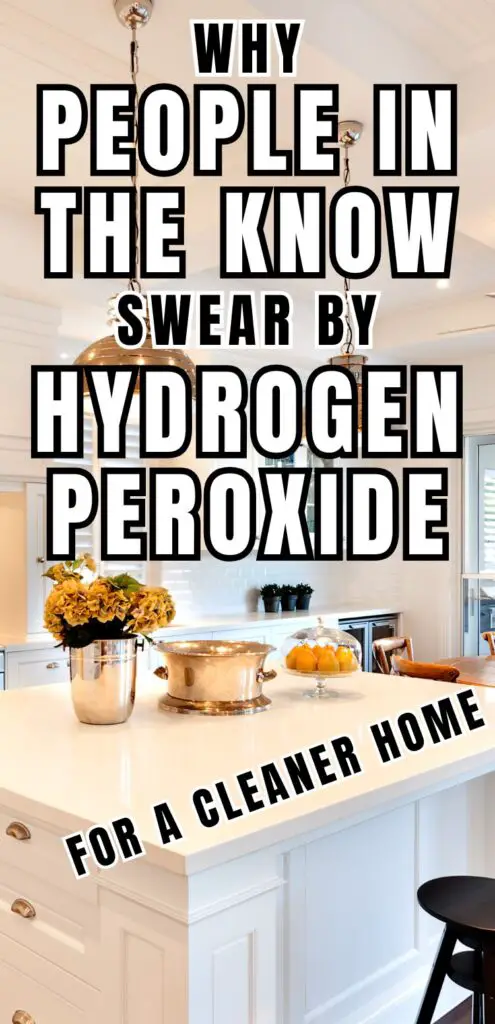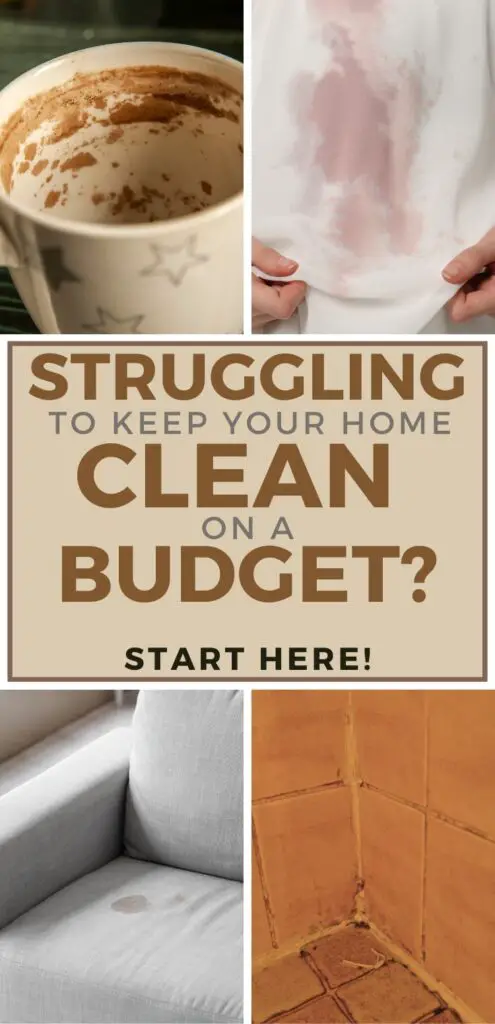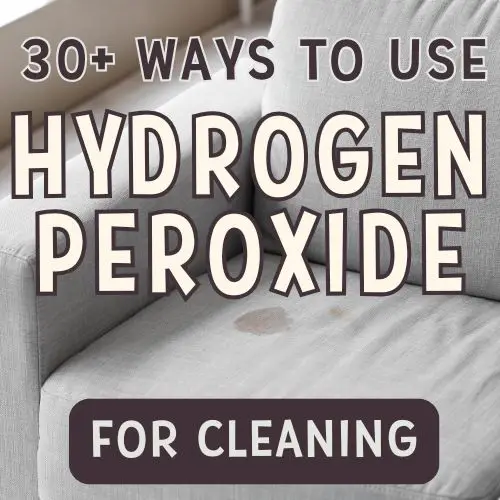You know that lonely brown bottle shoved in the back of your bathroom cabinet? The one that’s probably been sitting there since your last attempt at DIY first aid? Well, that little bottle of hydrogen peroxide cleaner is way more useful than you think.

If you’ve ever stared at a mysterious stain on your counter and wondered if it was worth losing your security deposit over, hydrogen peroxide might just be what you need. Turns out, this budget-friendly liquid isn’t just for cleaning cuts and making you feel like a medical professional.
It’s also a powerful ingredient when it comes to cleaning your home. It disinfects, deodorizes, and even whitens things without smelling like a chemical soup. Plus, using it might make you feel like a capable adult (even if your floordrobe says otherwise). Bonus: it’s cheap, non-toxic, and kind of mind-blowing.
In this post, we’ll break down the easiest, most effective ways to use hydrogen peroxide for cleaning—no hazmat suit or cleaning TikTok obsession required. Whether you’re looking to disinfect your bathroom, freshen up your kitchen, or just stop googling “is this mold toxic,” we’ve got you covered.
RELATED POST: 3 Simple DIY disinfectant sprays that work!
As an Amazon Associate I earn from qualifying purchases. This means if you click on a link and buy something I’ve recommended, I get a small commission at no additional cost to you. You can see my full Disclosure Policy here.
Why Use Hydrogen Peroxide for Cleaning?
Natural disinfectant: Hydrogen peroxide is basically nature’s bleach – without the headache-inducing fumes. It kills bacteria, viruses, and even mold spores by breaking them down into water and oxygen, so you can disinfect surfaces without harsh chemicals.
Non-toxic and eco-friendly: Unlike some cleaners that make you feel like you need to crack a window and wear gloves, hydrogen peroxide is safe for your home and the environment when used correctly. It doesn’t leave behind toxic residue and breaks down naturally, which means you can feel good about using it around pets and kids.
Affordable and accessible: A bottle of 3% hydrogen peroxide usually costs a few bucks and is available pretty much everywhere – from the drugstore to the dollar store. It’s one of those rare cleaning products that does a lot without making your wallet cry.
Safe (when used correctly): While hydrogen peroxide is gentle compared to bleach, it still has some bite – so it’s best to follow usage guidelines (like don’t mix it with vinegar in a closed container unless you’ want’re looking for an explosion). Used smartly, it’s a safe, effective option for everyday cleaning.

Hydrogen Peroxide Cleaning Basics
What strength to use (3% is your go-to): For most household cleaning tasks, the 3% solution you find at drugstores is perfect – strong enough to kill germs, but gentle enough to use on most surfaces. Higher concentrations exist but are meant for industrial use and can be dangerouse if handled without proper knowledge (or protective gear).
Start with a clean surface: Always clean surfaces with soap and water before using hydrogen peroxide to disinfect. If you skip this step, the peroxide will work on breaking down the debris left on the surface instead of breaking down bacteria, fungus and viruses.
How to store it properly: Hydrogen peroxide is light-sensitive, which is why it comes in that brown bottle – it breaks down when exposed to sunlight. To keep it effective, store it in a cool, dark place and avoid transferring it to a clear container unless you’re wrapping it in something that blocks light. You can check to see if hydrogen peroxide is still effective by pouring a small amount in your sink to see if it bubbles on contact with the metal drain. If it doesn’t, it’s time to buy a new one.
What not to mix it with (!!!): This one’s important: never mix hydrogen peroxide with vinegar or bleach. Vinegar + hydrogen peroxide = peracetic acid (a major irritant), and bleach + peroxide = toxic gas (yikes). Basically, it plays well on its own, so let it be the solo star of your cleaning show.
RELATED POST: How to get motivated to clean when you’re overwhelmed by the mess
Uses for Hydrogen Peroxide Cleaner In Your Home
Kitchen:
Cutting boards
Spray hydrogen peroxide directly onto cutting boards (especially after handling raw meat), let it sit for a few minutes, then rinse. It helps kill lingering bacteria and deodorizes without leaving an unpleasant after-smell like bleach does.
Countertops
Use it to disinfect counters after cooking – just spray, let it fizz for a bit, then wipe clean. It’s especially great on non-porous surfaces like granite, laminate, or quartz (but skip unsealed stone, as peroxide can dull it).Remove organic stains and ink from natural stone surfaces
Organic Stains
You can periodically use hydrogen peroxide on granite, sandstone, slate or quartzite for organic stains like coffee, tea or sauces. You can also try it on light colored marble. Pour a 1/2 teaspoon of hydrogen peroxide directly on the stain, let sit until the stain is gone, and remove with a damp cloth. Don’t use it as an everyday cleaner – regular use can damage the finish.
Fridge and Freezer Odors
Spray shelves, drawers, and rubber seals with hydrogen peroxide to disinfect and neutralize funky fridge smells. Wipe it down to remove any food first. It’s especially helpful if you have rotten food odors lingering in your appliance.
Remove Tea and Coffee Stains in Cups and Mugs
Pour enough undiluted hydrogen peroxide into the clean cup or mug to cover the stains. Let sit until the stain dissolves, then pour it into the next one. Rinse and dry.
Disinfect Sponges and Dishcloths
Soak your sponges and dishcloths in 3% hydrogen peroxide for 10 minutes. Rinse thoroughly with water and squeeze out any excess water. Let dry in direct sunshine if possible.
Sanitize Trash Can Liners
Eliminate odors and breeding grounds for fruit flies by disinfecting your trash can liner with hydrogen peroxide. Remember to wash it with soap and water first.
Bathrooms
Toilet bowls
Pour about half a cup of hydrogen peroxide into the bowl, let it sit for 15–30 minutes, then scrub and flush. It whitens and disinfects without needing a gas mask.
Grout
Spray hydrogen peroxide onto tile grout and let it bubble away grime – add a sprinkle of baking soda if you want to really get in there. It’s oddly satisfying to watch, like a science experiment that ends in a cleaner shower.
Sink slime
You know that gross pink stuff that builds up around your drain? Spray hydrogen peroxide on it and let it sit to kill bacteria and mildew. Bonus: it’ll foam up like it’s doing something dramatic, which is always nice.
Makeup brushes and applicators
Makeup brushes and applicators that are used regularly become petri dishes. To clean makeup brushes and applicators, pour equal parts warm water and hydrogen peroxide into a bowl. Add a drop of Dawn dish soap and place tool into the cleaning solution. Make sure to run your fingers all around the brush or applicator to get any dirt and debris out. Let it sit in the solution for 5-10 minutes, then rinse with cool water and let air dry on a clean towel.
Nail clippers, tweezers and other beauty tools
To sanitize beauty tools such as nail clippers, tweezers, etc., pour undiluted hydrogen peroxide into a bowl. Place the item in the bowl, make sure it is completely covered, and let sit for 15-30 minutes. Rinse in cool water and air dry on a clean towel.
Laundry
Stain removal
Pour hydrogen peroxide directly on stains like blood, wine, or pit stains. I’ve also used it to dissolve ground-in dirt stains. Let it sit and bubble for a few minutes, then toss it in the wash. Just do a spot test first on dark fabrics – it can bleach a bit if the fabric’s sensitive.
It’s also effective for removing oil and grease stains from clothes. Add a little baking soda and dish soap and you’re good to go!
Whitening whites
Add a cup of hydrogen peroxide to your whites in the washing machine to naturally brighten them without bleach. It’s great for reviving dingy socks, towels, and t-shirts that have turned a little gray.
Remove armpit and other yellow staining
To remove armpit stains or yellow tinge from lace curtains or tablecloths, pour hydrogen peroxide into a container just large enough to hold the item. Pour enough to ensure it’s completely soaked, and soak for at least an hour. Rinse in cold water and air dry, preferably in bright sunshine.
Deodorizing towels
Got some musty, sour-smelling towels? Add a half cup of hydrogen peroxide with your detergent to kill the bacteria that cause that funk. Your towels will come out fresher, fluffier, and much less offensive to the nose.
Remove mold and mildew from shower curtains
Remove mold and mildew from shower curtains, pour a cup of hydrogen peroxide into your washing machine, along with your usual laundry soap. Place a towel, along with the shower curtain in the machine and run it as usual. The peroxide will remove the mold and mildew and the towel will provide extra agitation to ensure the curtain comes out clean.
DIY OxiClean oxygen cleaner
Combine 1 part washing soda with 1 part hydrogen peroxide to whiten and brighten your laundry – even colors! You can also spray the mixture on to spot remove stains or to soak heavily soiled items.

Living Spaces
Organic carpet and furniture stains
Stains like blood, urine, vomit, wine and coffee can be removed from carpet and furniture with hydrogen peroxide. Remove any solid material and gently blot what you can with paper towels or a cloth before generously spraying the undiluted hydrogen peroxide onto the stain. Let sit until the stain disappears.
Light switches
Spray a little hydrogen peroxide on a cloth and wipe down light switches, which are basically germ factories. It’s a quick and easy way to disinfect without leaving any residue.
Remotes
Dampen a cloth or cotton swab with peroxide and clean your remote’s buttons and crevices (aka crumb collectors). It’s especially great during flu season or after kids have been using them with their sticky little hands.
Door handles
Wipe them down with hydrogen peroxide to get rid of the germs we unknowingly spread every time we go in or out. It’s a low-effort, high-reward habit that keeps your home healthier.
Spot clean mattress stains
You can spot clean organic mattress stains by spraying the stain generously with undiluted hydrogen peroxide. Let it sit until the stain is lifted. If the area dries before the stain is gone, spray it again and let sit. If this still doesn’t lift the stain, you can try a drop or two of Dawn dishwashing liquid mixed with the hydrogen peroxide to add an additional stain removing boost.
RELATED POST: 19 Household cleaning uses for Windex
Other Cleaning Uses for Hydrogen Peroxide
Toothbrushes
Soak your toothbrush head in a cup of hydrogen peroxide for about 5 minutes to kill bacteria. It’s a super simple way to prevent gross mouth germs from hanging around longer than they should. This also works for retainers, mouth guards or dentures.
Reusable water bottles
Give that Stanley cup – or Yeti bottle if you prefer – (and the cap!) a deep clean by filling it with hydrogen peroxide and letting it sit for 10–15 minutes, then rinse well. This helps kill hidden mold and bacteria, especially if you’ve been slacking on washing it regularly (no judgment).
Deodorize shoes
Peroxide is one of many ways to deodorize those stinky shoes using items you already have at home.
Lunch bags
Spritz the inside of insulated lunch bags to disinfect and eliminate smells. It’s a great weekly habit to get into—especially if your lunch sometimes leaks or your kid “forgets” their sandwich in there over the weekend.
Unclog and Deodorize Sink Drains
If you find your sink is draining slowly, try pouring a cup of baking soda down the drain, followed by a cup of hydrogen peroxide. Leave it to dissolve any organic matter buildup in the pipe for several hours, or even overnight if you can. Then pour very hot water into the drain until it runs clear. It will also help keep the pipes free of mildew and mold growth.
Disinfect reusable grocery bags
Reusable grocery bags are susceptible to bacteria and other germs because they hold food products that may leak. First, wash them with soap and hot water or run them through your washing machine and let air dry. Once dry, generously spray all surfaces of the bag – especially the seams – with undiluted hydrogen peroxide and allow it to air dry again, preferably in the sun.
Disinfect your washing machine
Wipe down your washing machine thoroughly with a damp cloth, ensuring you remove all dirt, hair and other organic matter. Pour 2 cups of hydrogen peroxide into your washing machine and run it through the hottest cycle.
Prevent mold in humidifiers
To prevent mold growth in your humidifier, add 1/4 cup of hydrogen peroxide each time you add water.
RELATED POST: Dishwashing hacks for people who hate washing dishes
Quick Recipes and How-To’s
DIY Disinfectant
Mix equal parts hydrogen peroxide and water in a dark spray bottle (remember, peroxide breaks down in light!). This makes a great everyday disinfectant for countertops, appliances, and other non-porous surfaces. Optional: add a few drops of essential oil for a fresh scent that makes you feel like a fancy clean person. Here’s a few more ideas for homemade disinfectant spray.
Mold/Mildew Spray
Spray 3% hydrogen peroxide directly on moldy areas like shower tiles, window tracks, or that smelly corner of the basement. Let it sit for 10–15 minutes, then scrub with a brush and rinse. You’ll probably see bubbling (it’s magic!), which means it’s working hard so you don’t have to.
Fabric Freshening Spray
Mix 1/2 cup hydrogen peroxide, 1/2 cup water, and a few drops of essential oil in a spray bottle. Mist it lightly over upholstery, curtains, gym bags, or musty towels to deodorize. Just avoid spraying on dark fabrics without testing first—it can lighten some materials if used heavily.
Floor Cleaner Hack
To ensure your floors are safe for babies, and pets too, you can sanitize your floors with hydrogen peroxide. Add about 1/4 cup of hydrogen peroxide to a bucket of warm water to mop tile or vinyl floors. It gently disinfects and brightens without any sticky residue or overpowering smell.
RELATED POST: How to make your own all-purpose cleaner
Proper usage and precautions
Hydrogen peroxide is generally safe, but it’s not totally harmless – so treat it like a responsible adult would (even if you’re just faking it till you make it). Stick to the 3% solution for household cleaning, and don’t go mixing it with other strong cleaners. And yes, wear gloves if your skin is sensitive.
Don’t use on these materials!
Skip hydrogen peroxide on natural surfaces like wood or metals – it can damage wood and cause oxidation (fancy word for rust) on metals. It can also bleach some fabrics, so always do a spot test first. Basically, if it’s expensive or absorbent, don’t take any chances.
Why you’ll wonder how you ever lived without it
Once you start using hydrogen peroxide to clean, you’ll be sorry you didn’t start sooner. It’s affordable, effective, and lets you skip the overpriced “miracle” products that promise the same results with twice the effort. Plus, there’s something deeply satisfying about watching it bubble the stains away.

